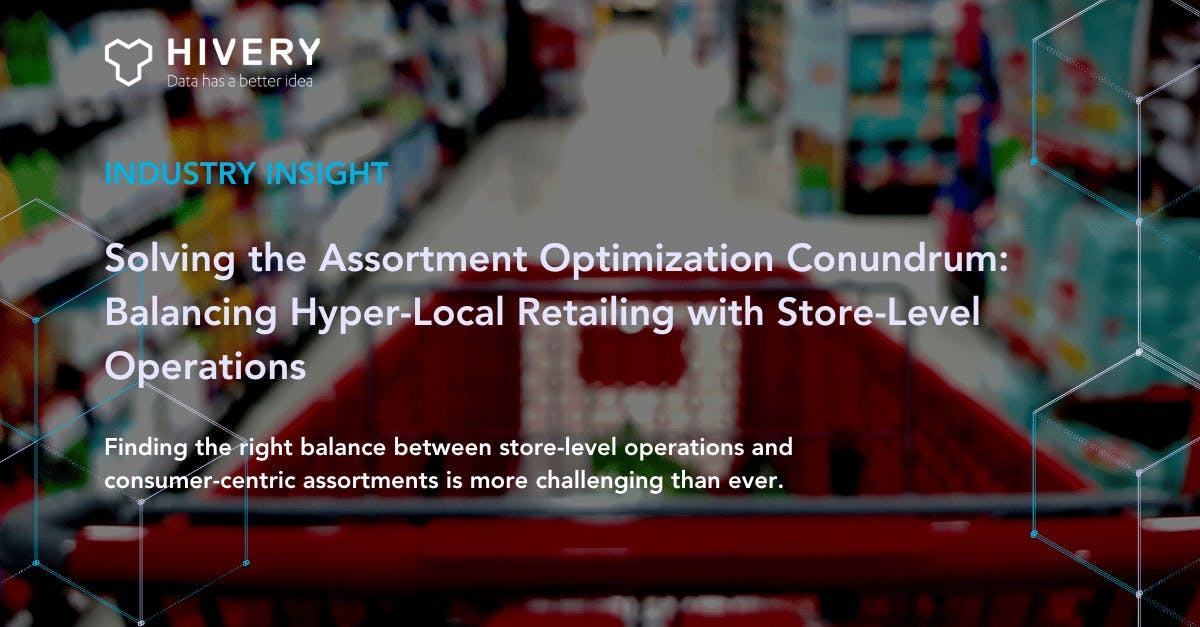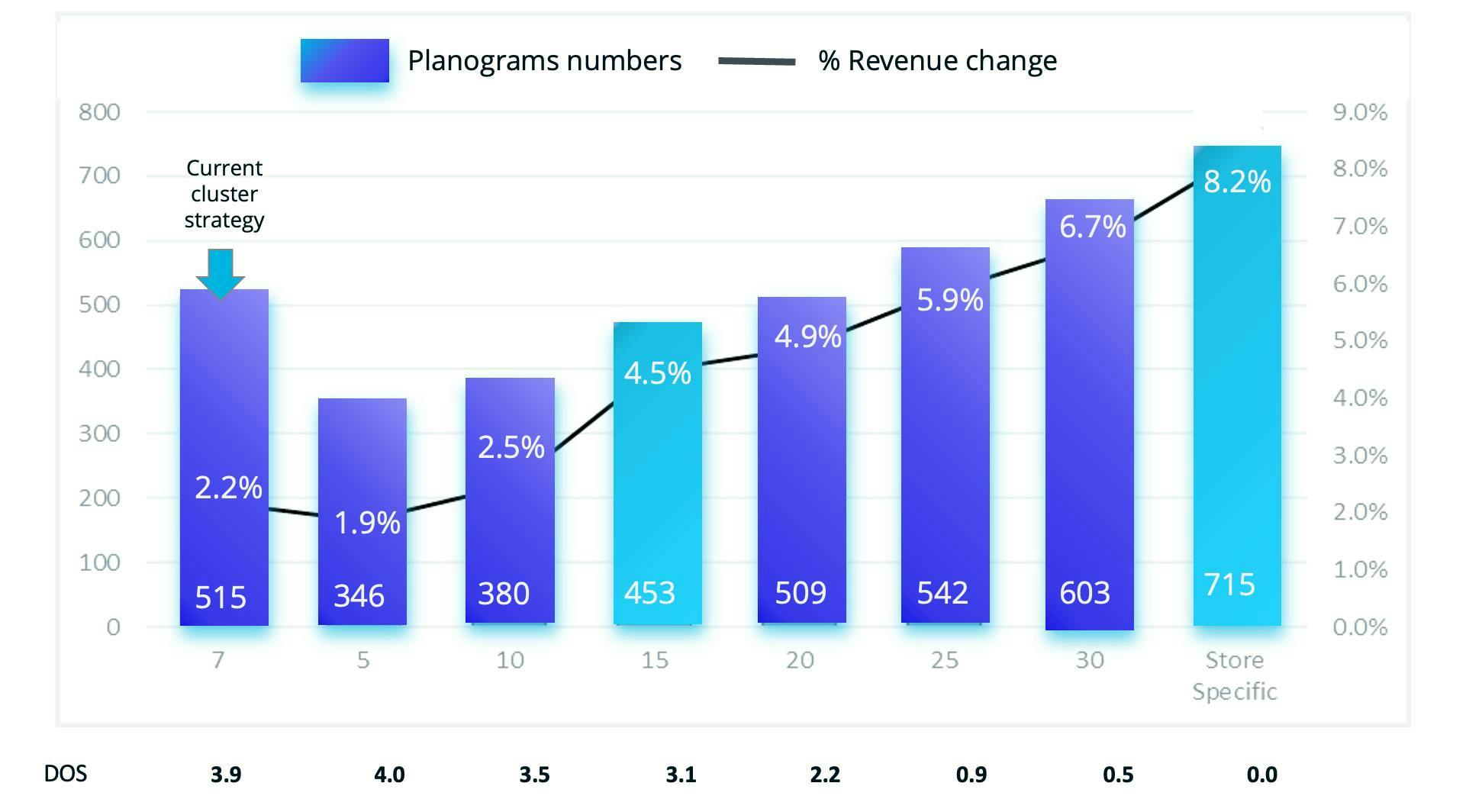
Solving the Assortment Optimization Conundrum: Balancing Hyper-Local Retailing with Store-Level Operations
Finding the right balance between store clusters, store-level operations, and consumer-centric assortments is more challenging than ever. AI-driven assortment optimization leveraging store-level data can help you strike the perfect balance for your business.
Unlocking the Power of Store-Level Shopper Insights
Typical grocery retailers stock products from over 10,000 manufacturers, and this number keeps growing as customer trends change and demand for new items, such as plant-based foods and organics. In recent times, the range of products offered has increased by up to 20%, with limited space determining the right products in the right stores has often resulted in "playing around" with the cluster counts, trying to optimize for them with the goal of being locally relevant, effectively merchandised, and operationally efficient.
Consumers today value choice and tend to shop at multiple stores rather than sticking to one. On average, shoppers visit 2.5 stores per week to fulfill their shopping needs. However, while shoppers appreciate variety, they also prefer easily accessible and convenient grocery stores that offer a one-stop-shopping experience. Thus, retailers meeting these requirements at one location tend to attract more customers while balancing operational costs and efficiency. As a result, category management and localized assortments are becoming increasingly important again.
Embracing the AI-Driven Approach to Category Management: The Key to Efficient Store-Level Operations
Category management must evolve from solutions created based on the mindset and knowledge from the 80s. The solutions often require manual and gut-feel workarounds, and, as a result, Category management teams have steered away from store-specific assortments. However, with an AI-driven approach, retailers can now strike a more effective and efficient balance when it comes to hyper-local retailing store-specific SKU's planning and execution. An AI-driven approach can optimize any store cluster level required by basing its analysis using store-specific insights. By analyzing store-level shopper data, retailers can bring consumer-centric assortments (Read: Hyperlocal Retailing: Shifting Focus to Customer Behavior-Based Hierarchies for more on this) to life while meeting business goals, adhering to store-level and national-level constraints and merchandising rules, as well as the impact of cannibalization.
The Growing Demand for Variety and Convenience and The Changing Landscape of Typical Retailers
Retailers today offer a vast array of products from 8000 different suppliers and manufacturers, with the number of brands and products continuing to grow. As consumers demand more choices, they also seek easily accessible, convenient, one-stop-shopping experiences. As a result, category management and localized assortments become increasingly important for retailers to meet these demands and stay competitive. Put simply, hyper-local retailing is the key to locally relevant, effectively merchandised, and operationally efficient.
The Power of AI-Driven Store-Specific Assortment Optimization - Untapping Potential of Hyper-Local Retailing
Current assortment optimization approaches have come a long way, but the significant unrealized potential exists in truly mastering consumer-centric and hyper-local retailing. Advanced analytics and AI can help retailers achieve this by moving beyond common assortments for all stores and optimizing each store's offerings based on local demand. Hyper-local retailing is a philosophy that leverages store-level data to inform shopper insights and optimize product and space offerings to individual stores' unique needs and preferences, regardless of the store cluster count being used. This approach uses store-level data, such as sales, product information, and store attributes, to gain precise insights. It enables retailers and supplier partners to provide a better product assortment that aligns with their customers' shopping needs and preferences.
Next-Level Assortment Optimization for Tomorrow - Striking the Right Balance with AI
Today's market offers various solutions for automating category management tactics, but many still rely on simplifications that don't fully support decision-making regarding the right level of differentiation vs. commonality. With AI-driven approaches, category managers can more effectively weigh the benefits of differentiation against the costs of increased complexity and the potential impact on sourcing, supply chain, and category management. They can use AI to run unlimited category strategy simulations to inform their decision-making rapidly.
Here is an example, you see different cluster strategies. Starting with the current strategy (far left) and using AI to run a different simulation to see the other ways to optimize assortments at the store level but ensure the strategy is more locally relevant, effectively merchandised, and operationally efficient. So what does the below reveal? By conducting store-level analysis and re-optimization, new cluster strategies can be discovered. For instance, the implementation of 'cyan color' strategies can result in 4.5% revenue growth with a lower number of planograms required (current 512 vs. new 380) and improve DOS performance by 21%. Opting for a store-specific approach yields the highest value, with an 8.2% revenue increase. The key point here is the ability to conduct rapid analysis and insight.

Advanced Understanding of Purchase Behavior for Profitable Outcomes With High-Performance Assortments
To stay ahead in an evolving market, retailers must sharpen their understanding of consumers with four key elements:
- Utilizing advanced modeling techniques based on store-level data, hence store-level insights
- Integrating merchandising rules, both at the national (i.e., DC and other supply chain requirements) and store level (i.e., store fixtures)
- Ensuring business objectives and goals are satisfied - both supplier and retail goals
- Respond to change rapidly and transparently: emerging shopper insights and unplanned market shocks (i.e., COVID-19), and, if you are a supplier, respond to retailers' requests while defending your brand and points of distribution (PODs)
The Evolution of Assortment Optimization Into the Next Generation Can be A Multi-Year Transformation Effort, But...
It does not need to be. Let's explain. Implementing state-of-the-art assortment optimization solutions is not an overnight process. Analytical and business processes must evolve over time and be in sync with ongoing operations. Furthermore, category managers' acceptance and adoption of data-driven decision-making are essential for AI to unleash its full impact on value. This may translate to a multi-year transformation effort but piloting or experimenting means you can do this today, validate the business case, and scale with confidence. Think of as simple as one category at one retail with agreed benchmarks for success.
Embracing the Future of Category Management & Adapting to an AI-Driven World Today
As the retail landscape evolves, so must category management strategies. By adopting AI-driven approaches to hyper-local retailing and store-level shopper analysis, retailers can create consumer-centric assortments that drive sales, profitability, and customer loyalty. This shift requires not only the implementation of advanced technologies but also a cultural change in the mindset of category managers and retail decision-makers. Watch this webinar titled Enabling Retail Space Management With AI, where Flora Delaney, Retail Consultant, and Author, talks about her work at Category Management Association and brings a new program to equip future category management professionals with skills and skills know-how to leverage AI-driven solutions.
Unleashing the Potential of AI in Retail & The Path to Success
To capitalize on the benefits of AI-driven category management, retailers must:
- Invest in advanced analytics and AI technologies
- Continuously evolve and refine business processes through clearly defined experimentation and pilots.
- Foster a culture of data-driven decision-making among category managers and other stakeholders
- Implement a multi-year transformation strategy that supports ongoing operations and change management
By taking these steps, retailers can unlock the full potential of AI-driven hyperlocal retailing and store-level shopper insights, revolutionizing category management and driving sustainable growth in an increasingly competitive market.
Talk to our expert, learn more, and request a demo of our AI offering: HIVERY Curate. Discover how hyperlocal retailing can revolutionize your retail operations and help you better serve your customers.